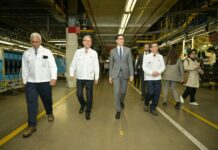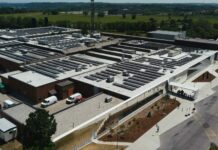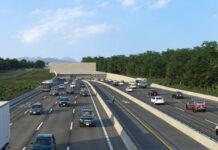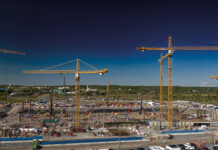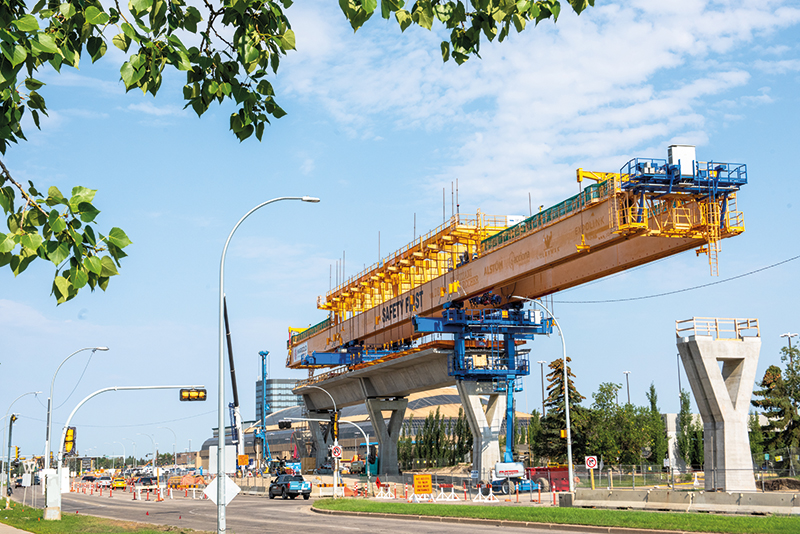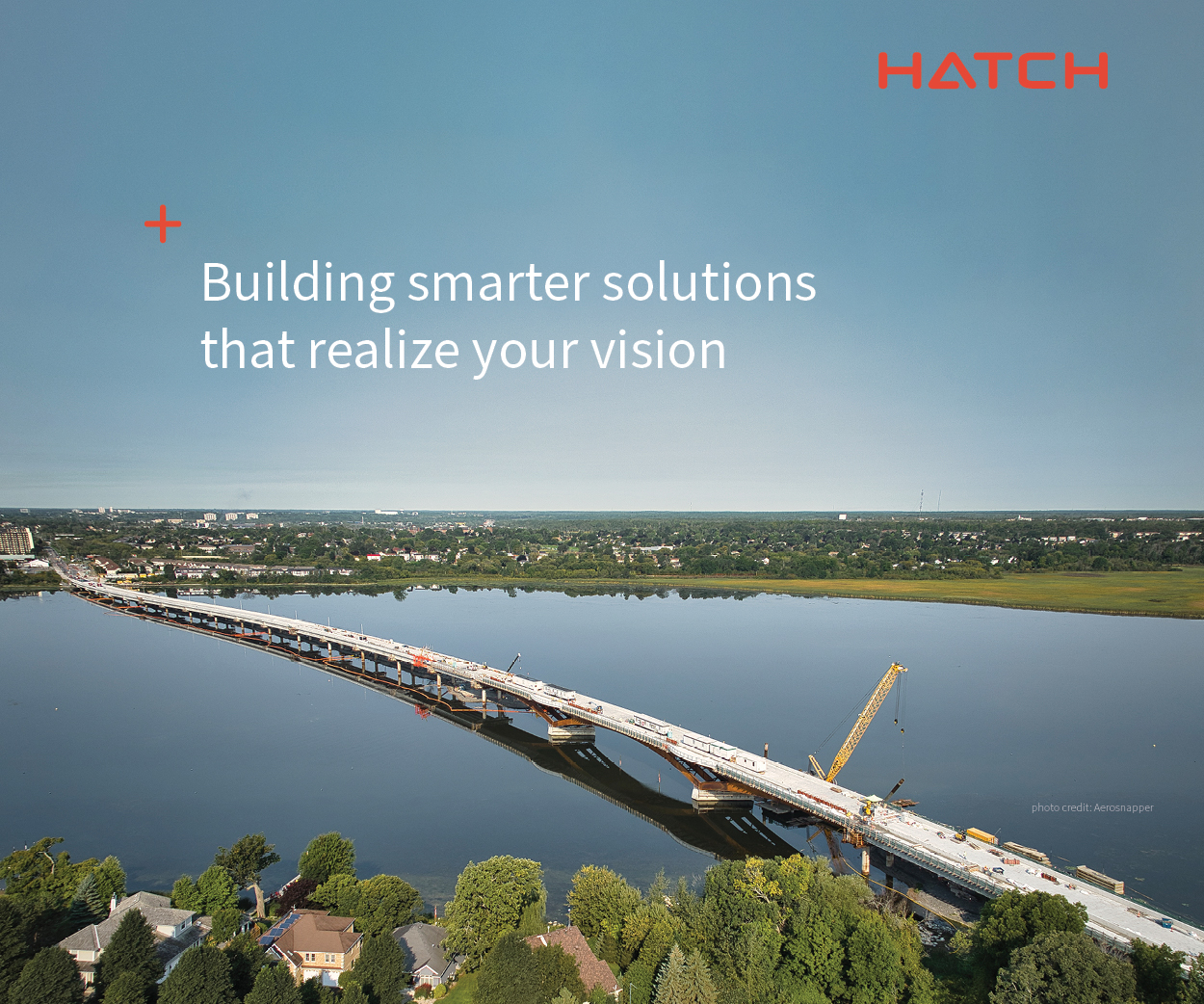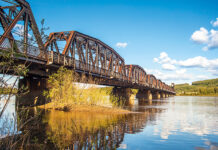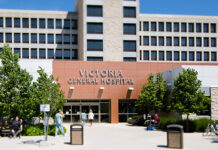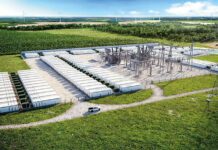By Brad Baumle
Over the last year, a 100-metre gantry crane has taken shape and loomed over west Edmonton. Piece-by-piece, it hoists up giant concrete segments and connects them to form the elevated guideway that will allow the Edmonton Valley Line West LRT trains to pass over. Located in a complex local environment of an emergency hospital and one of the busiest malls in the world, the gantry is a first-of-its-kind for Edmonton LRT construction and an integral part of delivering the project with minimal disruptions to local communities.
Valley Line West will add 14 kilometres of track from downtown, west, past the West Edmonton Mall out to Lewis Farms. Once complete, trains will run every five minutes along the route at peak times. Although most of the tracks are at grade, there is a 2.1-kilometre elevated guideway taking shape around West Edmonton Mall and the Misericordia Hospital. This is a high-traffic area that needs 24/7 access for emergency vehicles, so the project needs to be designed and delivered in a way that does not delay emergency vehicles getting into the hospital.
Marigold Infrastructure Partners is a joint venture made up of Colas and Parsons, bringing together strong local experience through subsidiaries like Standard General Edmonton, and experience on major global transit projects. The project started when COVID-19 restrictions were still very much in force, making it difficult for people with international experience to gather in person.
In designing and planning construction for a project of this scale, we had to instill local considerations in the minds of this largely virtual international team to ensure all the local communities, businesses and services along the route had been given proper consideration. Together with the City of Edmonton, we connected with key organizations and stakeholders early on to help inform them of our approach to construction and we continue to engage with these local groups on a regular basis to get their input to guide our approach.
Road closures off the table
In looking at options to construct the elevated guideway, we looked for the most efficient and least disruptive method. Typically, this would require us to:
- Close off sections of road and build supporting structures beneath the guideway.
- Build large shoring towers and run a form over the top in the shape of the section.
- Install steel rebar cages.
- Pour the concrete.
- Wait for the concrete to cure.
For each section this could take around three weeks to build the towers and form work, then one to three weeks for the concrete to cure, before lowering the form work and dismantling the towers. In total, this process could take somewhere in the region of two to two-and-a-half months for each section. To make this process more efficient, we recognized we needed to do something different, and the answer was in Dubai.
The massive gantry crane had been used to build some of the infrastructure around the 2020 Expo in Dubai. Using the gantry and prefabricated concrete segments had huge time-saving potential and offered major benefits for reducing local road closures. The crane was shipped from Dubai to Vancouver and travelled by train to Edmonton. The hydraulics were sent to Italy for a tune-up and shipped to Montreal before making their way across Canada to be assembled on 87 Avenue. The size of the crane, and the ongoing global supply chain issues at the time, meant getting all the parts on site was challenging to say the least.
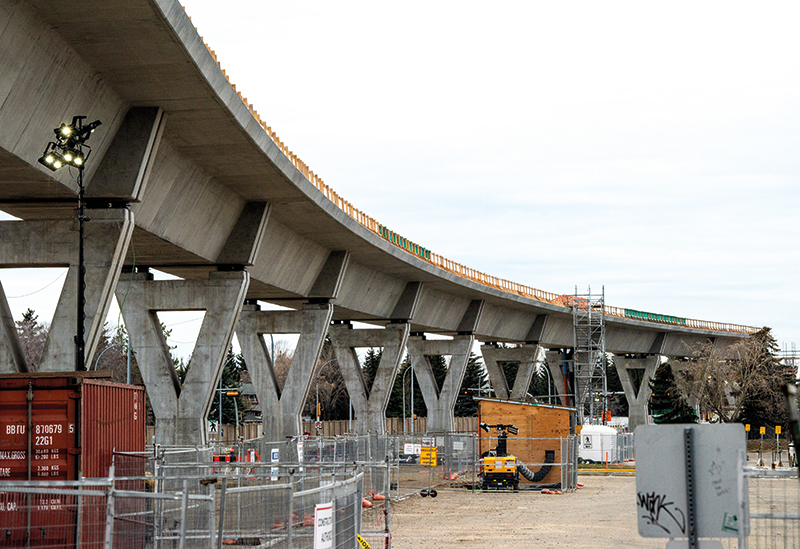
Offsite to onsite
Each 60-ton concrete segment (90,000 to 120,000 pounds) is manufactured by Eagle Builders, a local company based in Blackfalds, Alta., just north of Red Deer, that specializes in precast concrete. The company has been around since 2000 and hires over 500 people to build precast concrete segments for all types of construction projects.
Eagle Builders’ 300,000 square foot facility uses huge steel moulds to cast each segment in an indoor climate-controlled environment. A team of 20-25 people will prebuild the rebar skeleton within the mould and pour the concrete. The mould is built into the factory floor, retracts when the segment has cured, then the finished segment is hoisted off to be stored until it is needed on site. The whole process to produce each segment in the factory takes one to three weeks.
Feat of logistics and engineering
When the gantry crane is ready to start a new section, the huge 60-ton segments are placed on trucks and make their way to site in 45-minute intervals. Each section of elevated guideway requires between 10 and 14 segments. The gantry crane hoists each segment into position, using a winch, one by one, holding each segment in rough position. Tensioning cables are run through the segments and pull them together. Together, the segments are lowered into place. A high strength epoxy is applied, and the surfaces are finished.
As the crew of 10 people has become more familiar with the process, a 36-40 metre section of track can now be built in as little as two to three days, a time saving of up to 70 days when compared to the process of not using a gantry. With 47 sections of guideway making up the 2.1-kilometre elevated section, that time saving adds up to a significant reduction in disruption along a busy and important road.
For the main project elements that cause the most disruption, we have worked hard to find ways to expedite work. The old Stony Plain Road bridge over the busy Groat Road was dismantled over a weekend around New Year’s 2023, and the new girders put in place over a couple of days later in the year. We continue to find ways to accelerate the work, which will allow us to open the bridge as quickly as possible. Further west, another bridge crosses Anthony Henday Drive. For this scope of work, the girders were installed during two nights in January 2024, one side at a time to allow traffic to keep flowing along a critical arterial roadway in the city.
The importance of communication
Building something as large and complex as a light rail line will inevitably lead to road closures and other disruption. Regular ongoing communication with key partners continues to be critical for our planning. Early and ongoing discussions with the Misericordia Community Hospital and West Edmonton Mall gave us a strong understanding of the unique operational challenges we would need to overcome from day one. Ongoing communication with key partners will continue to be important in the year ahead as we aim to complete the elevated guideway and construction work on the two elevated stations at these two locations.
In partnership with the City of Edmonton, we have met with key organizations, businesses, community groups, educational and public institutions, and properties along the route. In many cases we have set up regular meetings to hear what is most important to them to see where it is possible to adjust our plans or mitigate impacts.
Project progress so far has been steady, and the year ahead will see some major project milestones. The LRT line is starting to take shape, with the elevated guideway expected to be complete by the end of the year. As with all large construction projects, unexpected challenges can arise, but we continue to put the impacts on the local community at the centre of our efforts to get this transformational project built on time with the least possible disruption. Once complete, Valley Line West LRT will give Edmontonians options to access more parts of the city, supporting Edmonton’s growth into a city of two million people over the upcoming decades.
Brad Baumle is construction manager at Marigold Infrastructure Partners.
[This article originally appeared in the March/April 2024 edition of ReNew Canada]
Featured image: Marigold Infrastructure Partners’ use of the gantry and prefabricated concrete segments had huge time-saving potential and offered major benefits for reducing local road closures during the construction of the Edmonton Valley West LRT. (Sovdi Media)

